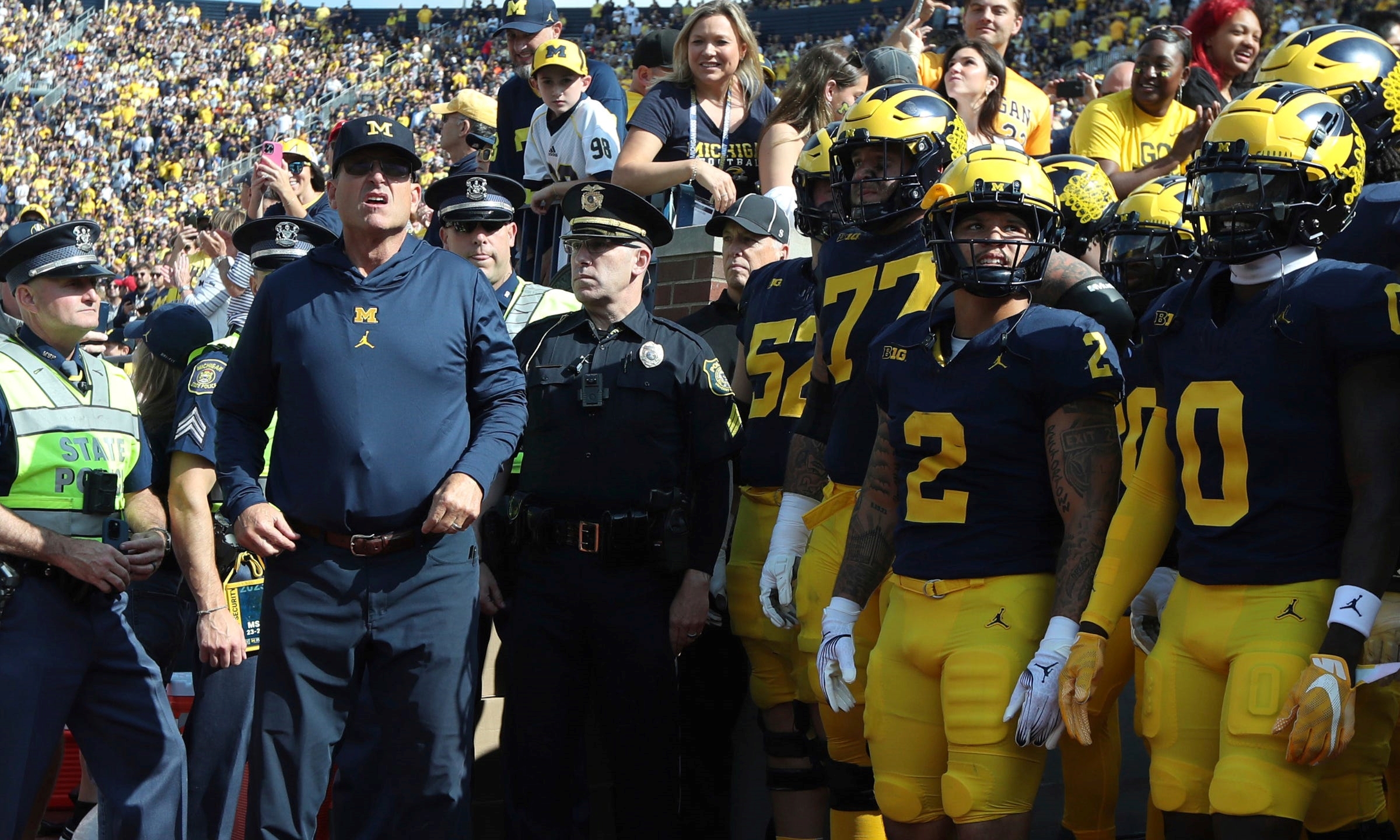Ad Disclosure

An 11-1 chaos scenario looms in the B1G East, with Michigan in the back seat
By Alex Hickey
Published:
The margins to determine the Big Ten East champion — and the number of B1G teams invited to the final 4-team College Football Playoff — look thinner than ever.
So thin that 1 yard and 1 second in a non-conference game could end up making a difference. Thanks to Ohio State’s 17-14 great escape at Notre Dame, there is now an unprecedented opening for what we’ll call the B1G Chaos Scenario.
The scenario?
Michigan, Ohio State and Penn State all finish 1-1 head-to-head against each other and win the remainder of their games, putting each team at 11-1. (i.e., Michigan beats Penn State and loses to Ohio State, but Penn State beats Ohio State. Or the other way around — the Nittany Lions beat the Wolverines but lose to the Buckeyes.)
It would be unprecedented for the Playoff era, and quite nearly in Big Ten history. We haven’t seen 3 1-loss teams tie for the conference title since 1967, when Indiana, Purdue and Minnesota each finished 7-1 in conference.
Of course, this would merely be a tie for the B1G East divisional title. And since this is the final year of divisional play in the B1G, only 1 of 3 CFP-caliber, top-10 teams would end up playing in the Big Ten championship game.
The other opponent would be the champion of what is shaping up to be the weakest Big Ten West race yet. And that’s saying a lot when most of those races have resembled Popeye before eating spinach.
Needless to say, the team that wins the tiebreaker to reach the Big Ten championship game will have the upper hand on a College Football Playoff berth. But the manner in which that tie is likely to be broken looms surprisingly large over the rest of the season.
A B1G tiebreaker deep dive
Back in the day, the championship tiebreaker was straightforward. Whichever team had gone the longest without representing the Big Ten in the Rose Bowl was named the conference’s representative.
In 1967, Indiana lost to Minnesota and beat Purdue. The Boilers beat the Gophers. But since the Hoosiers had gone a now-quaint 22 years since going to Pasadena, Indiana got the nod over the Boilermakers (1 year) and Gophers (6 years).
If those rules were still in place, Penn State would be in the driver’s seat. The Nittany Lions haven’t played in the Big Ten championship game since 2016.
Alas, those were simpler times. As life gets more complicated, so too do the rules for breaking ties.
According to the Big Ten rulebook, we may be looking at a doozy in 2023.
If Michigan, Penn State and Ohio State split their games and all finish 11-1, the division champion would likely be determined by the fifth tiebreaker:
5. The records of the 3 (or more) teams will be compared based on the best cumulative conference winning percentage of non-divisional opponents.
(a) Example: East 1 non-divisional opponents are 20-7, East 2 non-divisional opponents are 19-8, East 3 non-divisional opponents are 14-13 – East 1 would be the representative.
In plain English? Big Ten West teams will probably determine who wins the Big Ten East.
Who you play in cross-divisional games matters.
- Michigan: Nebraska, Minnesota, Purdue (Current B1G record: 1-3)
- Ohio State: Purdue, Wisconsin, Minnesota (Current B1G record: 1-3)
- Penn State: Illinois, Iowa, Northwestern (Current B1G record: 1-3)
With Wisconsin and Iowa being the most likely teams to finish atop the West jumble, Ohio State and Penn State are going to have a chance to pull away from Michigan in this department.
And the Wolverines could really be sunk if it goes to a 6th tiebreaker.
6. The records of the 3 (or more) teams will be compared against the highest placed non-divisional teams in their division order of finish (1, 2, 3, 4, 5, 6 and 7).
So, if Wisconsin were to end up winning the West, Ohio State would earn the tiebreaker for finishing 1-0 against the first-place team. If Iowa rebounds to win the West, Penn State would benefit for the same reason. And since it already looks safe to rule out Nebraska, Minnesota and Purdue, Michigan would be left with the short end of the stick.
And for the Wolverines, that’s a bigger deal in the CFP picture than it is for the Nittany Lions or Buckeyes.
Let’s say we get to the end of the season with Georgia and Florida State at 12-0. Either Texas or Oklahoma is 11-1 with a shot at a 12th win in the Big 12 championship game. There are a pair of 11-1 teams playing for the Pac-12 title. The winner also gets a 12th win.
Due to its soft non-conference schedule and the Big Ten’s tiebreaking procedure keeping it out of the title game, Michigan would likely find itself possessing the weakest resume of any CFP hopeful.
Obviously, we’re a long way from any of this being applicable. It could even be obsolete by next week.
But if this season unfolds in a way that unlocks the B1G Chaos Scenario, the Wolverines are the team most likely to be on the outside looking in.
Alex Hickey is an award-winning writer who has watched Big Ten sports since it was a numerically accurate description of league membership. Alex has covered college football and basketball since 2008, with stops on the McNeese State, LSU and West Virginia beats before being hired as Saturday Tradition's Big Ten columnist in 2021. He is an Illinois native and 2004 Indiana University graduate.